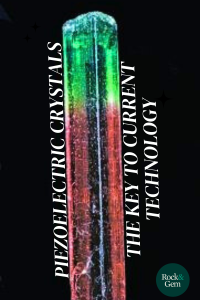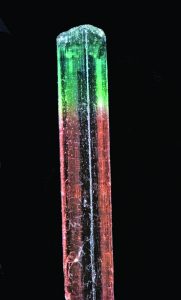
Piezoelectric crystals led the way to our smartphones responding almost magically to our requests; simply tapping their touch screens completes a remarkable variety of chores. Smartphones, of course, have no supernatural properties. However, what they do have are paper-thin, transparent, piezoelectrical films that convert the mechanical energy of tapping into electrical energy that activates the selected computer functions.

What is Piezoelectricity?
Piezoelectricity, the electrical current generated when certain crystalline materials are mechanically stressed, has become a big part of our everyday lives. Although modern piezoelectrical devices rely on advanced piezoceramic and piezochemical materials, our awareness and understanding of piezoelectricity began with natural crystals of tourmaline and quartz.
The name piezoelectricity stems from the Greek piezein, meaning “to press.” The science was first investigated by French researchers Jacques and Pierre Curie in 1880. The Curies found that mechanical pressure applied to tourmaline crystals generated a measurable electrical charge on opposing crystal faces. They also observed an inverse effect in which applied electrical current measurably deformed tourmaline crystals.

(Wikimedia Commons)
Piezoelectric Crystals
Certain other natural crystalline materials, notably quartz, also exhibit piezoelectrical properties. However, the exact cause of piezoelectricity was not explained until the 1920s after X-ray diffraction had revealed the nature of crystal-lattice structures.
The tourmaline-group minerals and quartz are silicates, in which silica tetrahedra join to form seven different structural groups. Tourmaline is a ring silicate or cyclosilicate; quartz is a tectosilicate or framework silicate. In both, silica tetrahedra link together in repetitive, closed configurations that provide incredible strength and rigidity. With their exceptional spatial stability, tourmaline and quartz deform only minimally when compressed. Instead of causing physical distortion, most of the mechanical energy applied to tourmaline and quartz crystals displaces ions from their normal lattice positions to produce an electrical potential—piezoelectricity.
Piezoelectricity & World War
Piezoelectricity remained a laboratory curiosity until the early 1900s, when thin, precisely cut quartz wafers mounted in hydrophone-like devices were found to generate a measurable microcurrent in response to the subtle pressure variations of underwater sound waves. Shortly after that, the sinking of the HMS Titanic in 1912 spurred interest in adapting quartz hydrophones to locate icebergs by detecting underwater echoes from artificially generated sound waves.
When World War I brought an urgent need for the ability to detect submarines, researchers quickly developed sonar (SOund NAvigation Ranging) as the first successful application of piezoelectricity.
Piezoelectric crystals, tourmaline and quartz, played significant roles in submarine warfare during World War II. Anti-submarine vessels employed sonars that used quartz-based hydrophones.
Additionally, submarines relied on tourmaline for one of their most vital instruments. When compressed by surrounding seawater, the thin tourmaline wafers mounted between submarines’ spars and hull plates generated piezoelectrical microcurrents. When amplified, the microcurrents moved gauge needles accurately to indicate water depth.
Piezoelectricity in Everyday Life
Piezoelectrical applications required electronic-grade crystals of tourmaline and quartz with high chemical purity and virtually no structural distortion. But such crystals were rare and found only in a few localities.
Most electronic-grade crystals came from Minas Gerais, Brazil, the tourmaline from granite pegmatites, and the quartz from massive shale formations. Smaller amounts of electronic-grade quartz were also mined from hydrothermal veins in Arkansas, while some electronic-grade tourmaline came from pegmatites in Maine and California.
Since World War II, the piezoelectrical properties of tourmaline and quartz have found many additional applications. Natural crystals of tourmaline and quartz have since been replaced by advanced, synthetic piezoceramic and piezochemical materials with far greater piezoelectrical sensitivities.
So when we tap a smartphone screen, remember that we are using a technology that originated with piezoelectric crystals and those early experiments on tourmaline and quartz.
This article about piezoelectric crystals previously appeared in Rock & Gem magazine. Click here to subscribe. Article by Steve Voynick.















